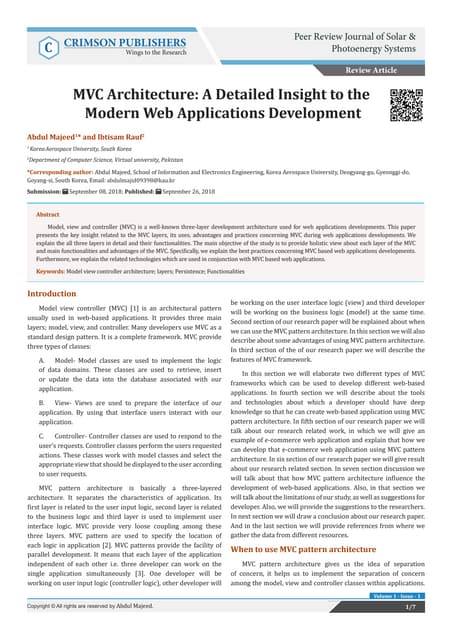Lecture 05 - Creating a website with Razor Pages.pdf
- 1. Creating a website with Razor Pages Instructor: MSc. Hoang Ngoc Long
- 2. Objective ┬¦ Creating a website with Razor Pages
- 3. Agenda ┬¦ Exploring a typical Razor Page ┬¦ The MVC design pattern ┬¦ Applying the MVC design pattern to Razor Pages ┬¦ Adding Razor Pages to your application ┬¦ MVC controllers in ASP.NET Core ┬¦ Razor Pages and page handlers
- 4. An introduction to Razor Pages ┬¦ The Razor Pages programming model was introduced in ASP.NET Core 2.0 as a way to build server-side rendered ŌĆ£page-basedŌĆØ websites. ┬¦ It builds on top of the ASP.NET Core infrastructure to provide a streamlined experience, using conventions where possible to reduce the amount of boilerplate code and configuration required. ┬¦ A page-based website is one in which the user browses between multiple pages, enters data into forms, and generally consumes content. This contrasts with applications like games or single-page applications (SPAs), which are heavily interactive on the client side.
- 5. Exploring a typical Razor Page ┬¦ A Razor Page for viewing all to-do items in a given category
- 6. Exploring a typical Razor Page ┬¦ A Razor Page for viewing all to-do items in a given category ŌĆó The pattern of interactions in the Razor Page shows a common pattern. ŌĆó The page handler is the central controller for the Razor Page. It receives an input from the user (the category method parameter), calls out to the ŌĆ£brainsŌĆØ of the application (the ToDoService) and passes data (by exposing the Items property) to the Razor view, which generates the HTML response.
- 7. The MVC design pattern ┬¦ In web development, MVC is a common paradigm and is used in frameworks such as Django, Rails, and Spring MVC. But as itŌĆÖs such a broad concept, you can find MVC in everything from mobile apps to rich-client desktop applications. ┬¦ The original MVC pattern has many different interpretations, each of which focuses on a slightly different aspect of the pattern. ŌĆó For example, the original MVC design pattern was specified with rich-client graphical user interface (GUI) apps in mind, rather than web applications, so it uses terminology and paradigms associated with a GUI environment. Fundamentally, though, the pattern aims to separate the management and manipulation of data from its visual representation.
- 8. The MVC design pattern ┬¦ The Model-View-Controller (MVC) pattern has been around since the 1970s, originally created as a pattern for use in Smalltalk. ŌĆó The pattern has made a resurgence recently, with implementations in many different and varied languages, including Java (Spring Framework), Ruby (Ruby on Rails), and .NET (ASP.NET MVC) ┬¦ Controller is centerpiece that decouples the Model and View ┬¦ Control flow: ŌĆó User interaction event ŌĆó Controller handles event and converts it to a user action the Model can understand ŌĆó Model manages the behavior and data of the application domain ŌĆó The View interacts with the Controller and Model to generate a user interface
- 9. Client/Server vs MVC Controller Model View Client ----------------------- Business Objects Server ----------------------- Business Objects Data
- 11. The MVC design pattern Figure shows how a Razor Page handles different aspects of a request, all of which combine to generate the final response.
- 12. The MVC design pattern ┬¦ Each component in the MVC design pattern is responsible for a single aspect of the overall system, which, when combined, can be used to generate a UI. ŌĆó Model ŌĆö This is the data that needs to be displayed, the global state of the application. ItŌĆÖs accessed via the ToDoService in above figure. ŌĆó View ŌĆö The template that displays the data provided by the model. ŌĆó Controller ŌĆö This updates the model and provides the data for display to the view. This role is taken by the page handler in Razor Pages. This is the OnGet method in above figure. ŌĆó The to-do list example considers MVC in terms of a web application using Razor Pages, but a request could also be equivalent to the click of a button in a desktop GUI application.
- 13. The MVC design pattern In general, the order of events when an application responds to a user interaction or request is as follows: 1) The controller (the Razor Page handler) receives the request. 2) Depending on the request, the controller either fetches the requested data from the application model using injected services, or it updates the data that makes up the model. 3) The controller selects a view to display and passes a representation of the model to it. 4) The view uses the data contained in the model to generate the UI.
- 14. The MVC design pattern ┬¦ Depending on the nature of the request, the controller may take a variety of actions, but the key point is that the actions are undertaken using the application model. ŌĆó Consider a request to view a product page for an e-commerce application. The controller would receive the request and would know how to contact some product service thatŌĆÖs part of the application model. This might fetch the details of the requested product from a database and return them to the controller. ŌĆó Alternatively, imagine that a controller receives a request to add a product to the userŌĆÖs shopping cart. The controller would receive the request and most likely would invoke a method on the model to request that the product be added. The model would then update its internal representation of the userŌĆÖs cart, by adding, for example, a new row to a database table holding the userŌĆÖs data. ┬¦ You can think of each Razor Page handler as a mini controller focused on a single page. Every web request is another independent call to a controller that orchestrates the response. Although there are many different controllers, the handlers all interact with the same application model.
- 15. Applying the MVC design pattern to Razor Pages ┬¦ ASP.NET Core implements Razor Page endpoints using a combination of RoutingMiddleware and EndpointMiddleware
- 16. Directing a Request to a Razor Page and Building a Binding Model ┬¦ Routing takes the headers and path of the request, for example /category/Simple, and maps it against a preregistered list of patterns. These patterns each match a path to a single Razor Page and page handler. ┬¦ Once a page handler is selected, the binding model (if applicable) is generated. This model is built based on the incoming request, the properties of the PageModel marked for binding, and the method parameters required by the page handler ┬¦ A binding model is normally one or more standard C# objects, with properties that map to the requested data.
- 17. Directing A Request To A Razor Page And Building A Binding Model ┬¦ Routing a request to a controller and building a binding model. A request to the /category/Simple URL results in the CategoryModel.OnGet page handler being executed, passing in a populated binding model, category.
- 18. Executing A Handler Using The Application Model ┬¦ The role of the page handler as the controller in the MVC pattern is to coordinate the generation of a response to the request itŌĆÖs handling ŌĆó Validate that the data contained in the binding model provided is valid for the request ŌĆó Invoke the appropriate actions on the application model using services ŌĆó Select an appropriate response to generate based on the response from the application model When executed, an action will invoke the appropriate methods in the application model The domain model encapsulates complex business logic in a series of classes that donŌĆÖt depend on any infrastructure and can be easily tested..
- 19. Building HTML Using The View Model ┬¦ A view model in the MVC pattern is all the data required by the view to render a UI. ItŌĆÖs typically some transformation of the data contained in the application model, plus extra information required to render the page, such as the pageŌĆÖs title. ┬¦ The term view model is used extensively in ASP.NET Core MVC, where it typically refers to a single object that is passed to the Razor view to render. However, with Razor Pages, the Razor view can access the Razor PageŌĆÖs page model class directly. ┬¦ The Razor Page PageModel typically acts as the view model in Razor Pages, with the data required by the Razor view exposed via properties.
- 20. Building HTML Using The View Model The page handler builds a view model by setting properties on the PageModel. ItŌĆÖs the view that generates the response.
- 21. Putting It All Together: A Complete Razor Page Request LetŌĆÖs put it all together from request to response. The figure shows how the steps combine to handle the request to display the list of to-do items for the ŌĆ£SimpleŌĆØ category.
- 22. Adding Razor Pages to your application ┬¦ The MVC infrastructure, whether used by Razor Pages or MVC/API controllers, is a foundational aspect of all but the simplest ASP.NET Core applications, so virtually all templates include it configured by default in some way. ┬¦ HereŌĆÖs how you add Razor Pages to your application: 1) In Visual Studio 2019, choose File > New > Project or choose Create a New Project from the splash screen. 2) From the list of templates, choose ASP.NET Core Web Application, ensuring you select the C# language template 3) On the next screen, enter a project name, location, and solution name, and click Create. 4) On the following screen, create a basic template without MVC or Razor Pages by selecting the ASP.NET Core Empty project template in Visual Studio. You can create a similar empty project using the .NET CLI with the dotnet new web command.
- 23. Adding Razor Pages to your application
- 24. Adding Razor Pages to your application 5) Add the necessary Razor Page services (shown in bold) in your Startup.cs fileŌĆÖs ConfigureServices method: 6) Replace the existing basic endpoint configured in the EndpointMiddleware at the end of your middleware pipeline with the MapRazorPages() extension method. For simplicity, also remove the existing error handler middleware from the Configure method of Startup.cs for now:
- 25. Adding Razor Pages to your application 7) Right-click your project in Solution Explorer and choose Add > New Folder to add a new folder to the root of your project. Name the new folder ŌĆ£PagesŌĆØ. 8) Right-click the new pages folder and choose Add > Razor Page
- 26. Adding Razor Pages to your application 9) On the following page, select Razor Page ŌĆō Empty and click Add. In the following dialog box, name your page Index.cshtml
- 27. Adding Razor Pages to your application 10) After Visual Studio has finished generating the file, open the Index.cshtml file, and update the HTML to say Hello World! by replacing the file contents with the following:
- 28. Adding Razor Pages to your application ┬¦ Once youŌĆÖve completed all these steps, you should be able to restore, build, and run your application. ŌĆó You can run your project by pressing F5 from within Visual Studio (or by calling dotnet run at the command line from the project folder). This will restore any referenced NuGet packages, build your project, and start your application. Visual Studio will automatically open a browser window to access your applicationŌĆÖs home page.
- 29. MVC controllers in ASP.NET Core ┬¦ In previous section we looked at the MVC design pattern, and at how it applies to Razor Pages in ASP.NET Core. Perhaps unsurprisingly, you can use the ASP.NET Core MVC framework in almost exactly the same way. ŌĆó Use Razor Pages for server-side rendered applications, and use the MVC framework for building Web APIs. ┬¦ Instead of a PageModel and page handler, MVC uses the concept of controllers and action methods. These are almost directly analogous to their Razor Pages counterparts. ┬¦ An action (or action method) is a method that runs in response to a request. An MVC controller is a class that contains a number of logically grouped action methods.
- 30. MVC controllers in ASP.NET Core
- 31. A complete MVC controller request for a category. The MVC controller pattern is almost identical to that of Razor Pages. The controller is equivalent to a Razor Page, and the action is equivalent to a page handler.
- 32. An MVC controller for viewing all to-do items in a given category
- 33. Comparing the folder structure for an MVC project to the folder structure for a Razor Pages project The benefits of Razor Pages
- 34. The benefits of Razor Pages ┬¦ The MVC approach traditionally groups classes by type (controller, view, view model), while the Razor Page approach groups by function ŌĆö everything related to a specific page is co-located. ŌĆó Using Razor Pages means much less scrolling up and down between the controller, views, and view model folders whenever youŌĆÖre working on a particular page. Everything you need is found in two files, the .cshtml Razor view and the .cshtml.cs PageModel file. ┬¦ Each Razor Page is cohesive for a particular feature, such as displaying a to-do item. MVC controllers contain action methods that handle multiple different features for a more abstract concept, such as all the features related to to-do items. ┬¦ The benefits of using Razor Pages are particularly noticeable when you have ŌĆ£contentŌĆØ websites, such as marketing websites, where youŌĆÖre mostly displaying static data, and thereŌĆÖs no real logic.
- 35. When to choose MVC controllers over Razor Pages ┬¦ When you donŌĆÖt want to render views ŌĆö Razor Pages are best for page-based applications, where youŌĆÖre rendering a view for the user. If youŌĆÖre building a Web API, you should use MVC controllers instead. ┬¦ When youŌĆÖre converting an existing MVC application to ASP.NET Core ŌĆö If you already have an ASP.NET application that uses MVC, itŌĆÖs probably not worth converting your existing MVC controllers to Razor Pages. ┬¦ When youŌĆÖre doing a lot of partial page updates ŌĆö ItŌĆÖs possible to use JavaScript in an application to avoid doing full page navigations by only updating part of the page at a time. This approach, halfway between fully server-side rendered and a client-side application may be easier to achieve with MVC controllers than Razor Pages.
- 36. When not to use Razor Pages or MVC controllers ┬¦ If youŌĆÖre building small, light-weight apps for the cloud, you might consider using custom middleware directly or an alternative protocol like gRPC ŌĆó https://docs.microsoft.com/aspnet/core/grpc ┬¦ If youŌĆÖre building an app with real-time functionality, youŌĆÖll probably want to consider using WebSockets instead of traditional HTTP requests. ŌĆó ASP.NET Core SignalR can be used to add real-time functionality to your app by providing an abstraction over WebSockets. ŌĆó SignalR also provides simple transport fallbacks and a remote procedure call (RPC) app model. For details, see the documentation at https://docs.microsoft.com/aspnet/core/signalr ┬¦ Another option available in ASP.NET Core 5.0 is Blazor. ŌĆó This framework allows you to build interactive client-side web applications by either leveraging the WebAssembly standard to run .NET code directly in your browser, or by using a stateful model with SignalR. ŌĆó See the documentation for details, at https://docs.microsoft.com/aspnet/core/blazor/
- 37. Razor Pages and page handlers ┬¦ In the MVC design pattern, the controller receives a request and is the entry point for UI generation. For Razor Pages, the entry point is a page handler that resides in a Razor PageŌĆÖs PageModel. A page handler is a method that runs in response to a request. ŌĆó By default, the path of a Razor Page on disk controls the URL path that the Razor Page responds to. For example, a request to the URL /products/list corresponds to the Razor Page at the path pages/Products/List.cshtml. ┬¦ The responsibility of a page handler is generally threefold: ŌĆó Confirm that the incoming request is valid. ŌĆó Invoke the appropriate business logic corresponding to the incoming request. ŌĆó Choose the appropriate kind of response to return.
- 38. Razor Pages and page handlers ┬¦ Page handlers typically return one of three things: ŌĆó A PageResult object ŌĆöThis causes the associated Razor view to generate an HTML response. ŌĆó Nothing (the handler returns void or Task) ŌĆöThis is the same as the previous case, causing the Razor view to generate an HTML response. ŌĆó A RedirectToPageResult ŌĆö This indicates that the user should be redirected to a different page in your application. ┬¦ ItŌĆÖs important to realize that a page handler doesnŌĆÖt generate a response directly; it selects the type of response and prepares the data for it. ŌĆó For example, returning a PageResult doesnŌĆÖt generate any HTML at that point; it merely indicates that a view should be rendered. ┬¦ ItŌĆÖs also worth bearing in mind that page handlers should generally not be performing business logic directly. Instead, they should call appropriate services in the application model to handle requests. ŌĆó If a page handler receives a request to add a product to a userŌĆÖs cart, it shouldnŌĆÖt directly manipulate the database or recalculate cart totals, for example. Instead, it should make a call to another class to handle the details.
- 39. Accepting parameters to page handlers ┬¦ The request may contain additional values from a variety of different sources. They could be part of the URL, the query string, headers, or the body of the request itself. ┬¦ The process of extracting values from a request and converting them to .NET types is called model binding. ┬¦ ASP.NET Core can bind two different targets in Razor Pages: ŌĆó Method arguments ŌĆö If a page handler has method arguments, the values from the request are used to create the required parameters. ŌĆó Properties marked with a [BindProperty] attribute ŌĆöAny properties marked with the attribute will be bound. ┬¦ Model-bound values can be simple types, such as strings and integers, or they can be a complex type.
- 40. Example Razor Page handlers
- 41. Returning responses with ActionResults ┬¦ ItŌĆÖs the IActionResult returned by a page handler that, when executed by the Razor Pages infrastructure using the view engine, will generate the response ┬¦ ASP.NET Core has many different types of IActionResult: ŌĆó PageResult ŌĆö Generates an HTML view for an associated page in Razor Pages ŌĆó ViewResult ŌĆö Generates an HTML view for a given Razor view when using MVC controllers ŌĆó RedirectToPageResult ŌĆö Sends a 302 HTTP redirect response to automatically send a user to another page ŌĆó RedirectResult ŌĆö Sends a 302 HTTP redirect response to automatically send a user to a specified URL (doesnŌĆÖt have to be a Razor Page) ŌĆó FileResult ŌĆö Returns a file as the response ŌĆó ContentResult ŌĆö Returns a provided string as the response ŌĆó StatusCodeResult ŌĆö Sends a raw HTTP status code as the response, optionally with associated response body content ŌĆó NotFoundResult ŌĆö Sends a raw 404 HTTP status code as the response
- 42. PageResult and RedirectToPageResult A typical POST, REDIRECT, GET flow through a website. A user sends their shopping basket to a checkout page, which validates its contents and redirects to a payment page without the user having to manually change the URL.
- 43. NotFoundResult and StatusCodeResult ┬¦ As well as HTML and redirect responses, youŌĆÖll occasionally need to send specific HTTP status codes. ŌĆó If you request a page for viewing a product on an e-commerce application, and that product doesnŌĆÖt exist, a 404 HTTP status code is returned to the browser, and youŌĆÖll typically see a ŌĆ£Not foundŌĆØ web page. ŌĆó Razor Pages can achieve this behavior by returning a NotFoundResult, which will return a raw 404 HTTP status code. ŌĆó You could achieve a similar result using StatusCodeResult and setting the status code returned explicitly to 404. ŌĆó You can use the StatusCodePagesMiddleware to intercept this raw 404 status code after itŌĆÖs been generated and provide a user-friendly HTML response for it.
- 44. End of Lecture

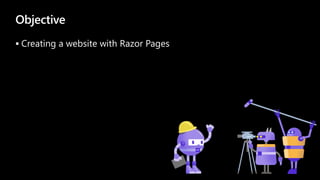

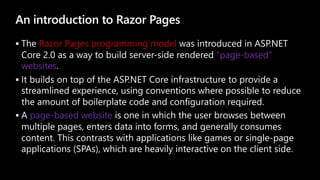

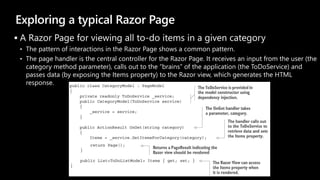

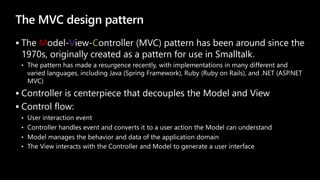






























![Accepting parameters to page handlers
┬¦ The request may contain additional values from a variety of different
sources. They could be part of the URL, the query string, headers, or
the body of the request itself.
┬¦ The process of extracting values from a request and converting them
to .NET types is called model binding.
┬¦ ASP.NET Core can bind two different targets in Razor Pages:
ŌĆó Method arguments ŌĆö If a page handler has method arguments, the values from the request
are used to create the required parameters.
ŌĆó Properties marked with a [BindProperty] attribute ŌĆöAny properties marked with the attribute
will be bound.
┬¦ Model-bound values can be simple types, such as strings and
integers, or they can be a complex type.](https://image.slidesharecdn.com/lecture05-creatingawebsitewithrazorpages-231010035103-4121fd4a/85/Lecture-05-Creating-a-website-with-Razor-Pages-pdf-39-320.jpg)






























